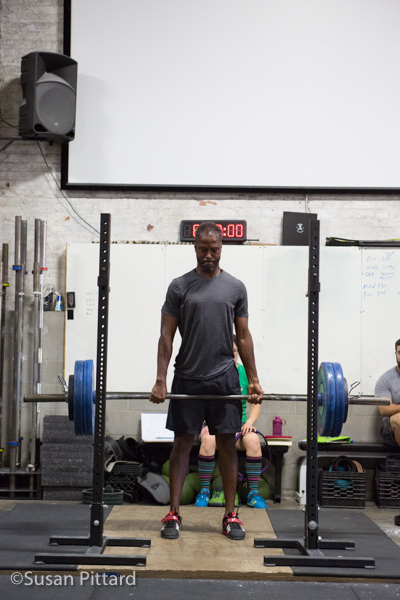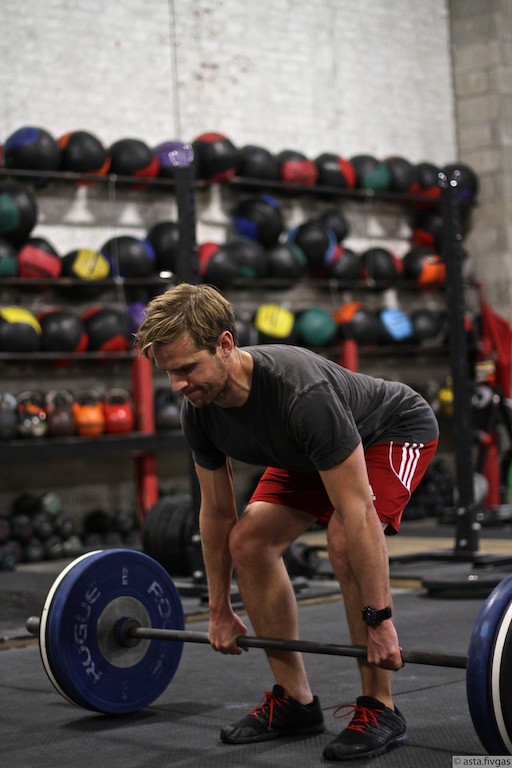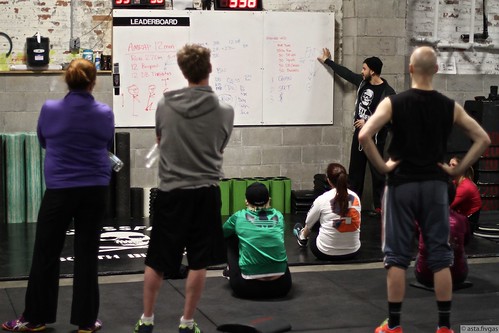How to Program Deadlifts at CrossFit Affiliates
 Monday, November 17, 2014 at 12:00AM
Monday, November 17, 2014 at 12:00AM
A few weeks ago, I had the opportunity to visit another gym while on vacation. I was excited to go and especially since starting to write ITA, I've become even more curious about how other people run classes and write their programming. At this affiliate, the strength segment called for a 3RM deadlift, followed by 10RM deadlift. At the whiteboard review, there wasn't a lot of context provided for the less experienced athletes regarding how to organize their lifting to meet the two goals. Curious about the intention of the programming, I approached the coach and asked her three relatively basic questions: 1) Are these touch-and-go or dead start deadlifts; 2) How many attempts at the 3RM and 10RM are you expecting us to do; and 3) Do you have any guidance as to how to pick a 10RM weight based on the 3RM. In a noncommittal tone, she told me to do whatever I felt like doing since it wasn't specified.
Looking around the room, unable to turn off my coaching eye, people seemed to be just winging it, making multiple attempts at 3 and 10RMs, dropping the bar frequently, and some were losing their positioning from the accumulated fatigue. Without proper context and guidance, people were more or less left to their own devices to figure out the programming and a few were overextending themselves beyond what they could organize and handle. The coach was walking around trying to help people with fault corrections, but refining movement is only one part of what makes an effective and professional coach. Understanding the intention of your programming, communicating it effectively, and then being able to scale or modify based on what you see are equally important, and unfortunately were in short shift during this segment.
I've wanted to write an article about programming deadlifts at CrossFit affiliates for a while and my experience at this gym brought it back to the forefront of my mind. Executed correctly, the deadlift is the most effective exercise for overloading hip extension and developing a strong and stable back. But done incorrectly or programmed haphazardly, the deadlift is an extremely effective way to fuck yourself or your members up. In today's article, we'll discuss how we program deadlifts at CFSBK for strength versus using them in metcons, and we’ll share some additional thoughts related to basic execution of the lift and context of usage.
 Use Deadlifts Primarily for Strength Development
Use Deadlifts Primarily for Strength Development
Remember: exercises are simply tools for attaining physical attributes. Each tool may be appropriate for more than one setting but there is often a most effective use for any given tool. With the deadlift, training for basic pulling strength is the most germane and adaptable way we can program the lift and therefore should be the primary way we use it. Not only can you squeeze years of slow and steady progress out of the deadlift, but getting a heavy, well-executed deadlift builds the foundation in the trunk for every other exercise which requires keeping your back locked in extension. The 150lb female athlete with a 265lb deadlift is much better at swinging a kettlebell for reps than a similarly sized counterpart who can only pull 205 for a single.
Separate Your Programming Into Levels
Novices at your gym have no business performing max effort lifting and going too heavy to satisfy the ego and excite a newbie is a recipe for disaster. CFSBK’s Fitness level programming consists of weekly progressions in which novice lifters work up to a single work set of five reps. We try to start people with something that feels a little "too light" and then encourage them to add 5-10 lbs each week to progressively train the lift as opposed to testing its full capacity. This gives people time to develop strength, practice the motor pattern, and build up the soft tissue integrity to support heavier weights. Want to throw an old dude’s back out and have him never come back to your gym? Tell him to pick up as much as he can regardless of how he does it, and then applaud the process. (Obviously don't do this.)
For intermediate and advanced level athletes, you can begin to play with more variables like percentage work, rep outs, and volume days to further strength. Changing the range-of-motion as seen in Rack and Deficit pulls are also possible variables to consider. At CFSBK, we have even very successfully used banded dynamic effort work to put a surprising amount of weight onto some of our better deadlifters. Read more about how to perform these variables and consider gradually introducing them into your affiliate programming but be discerning regarding who needs more complexity in their training, and who simply needs to lift a little more than last time.
 Dead Starts and Dropped Bars in Strength Training
Dead Starts and Dropped Bars in Strength Training
While performing a heavy touch-and-go set of deadlifts is certainly still an expression of strength, pulling the bar off the floor from a dead stop is the best way to develop basic pulling strength and is literally the reason it's called a deadlift. Additionally, dead starts optimally teach people how to properly set up and brace before lifting something heavy—a very valuable physical skill. If you always touch-and-go your sets, you're doing a huge disservice to yourself and missing out on important training that could strengthen your back and protect you for years to come.
Similarly, if athletes drop the weight each time or too frequently, they lose an opportunity to learn how to properly put down a heavy barbell. This portion of the lift becomes incredibly important when you want to transfer that ability to maintaining locked extension and an efficient bar path during touch-and-go deadlifts in metcons (which we'll discuss a little later). I think it's also just sloppy to drop the bar every time you're pulling for weight. Finish what you started, dammit. It's always bothered me that people would focus so much on how to pick something heavy up but then more or less ignore how to put it back down. Don't be lazy—make the deadlift hard by taking full advantage of all its components, and apply that intention to your programming so your athletes know what's specifically expected of them.
Managing Stress
Because of how much the average person can pull off the floor relative to their other lifts, deadlifts are measurably the most potent weight lifting exercise we can perform. This is a good thing, but not without consequence if overused. Moving all that weight takes a toll on the body and can be a bitch to recover from. When going heavy, keep the overall volume low and the intensity saved for the work set or sets.
Assuming they moved well, below is an example of how we might tell a hypothetical new 155lb adult male at the gym to approach their training on a day we're continuing a linear progression where the athlete works up to a single heavy set of five.
Warm-Ups
75x5x2
95x5
115x3
Work Set:
135x5
Explain to your members that deadlifts are potent medicine and that they shouldn’t go overboard with how much weight or volume they attempt on a typical training day. A novice, or even intermediate athlete, performing a heavy set of 5x5 deadlifts can easily overwhelm their ability to recover from it and in turn, compromise a week or more of workouts as they recover from the stress. Given the deadlift’s potency, start with a modest dose and very gradually increase your ability to pull heavier loads and higher volume.
Using Deadlifts in Metcons
Performing deadlifts for reps is a staple in CrossFit-style metcons and in our opinion, being able to organize the movement under some duress is a sensible component of a well-rounded fitness program. That being said, performing touch-and-go deadlifts is a skill that needs to be taught and we often review the mechanics of how to properly touch-and-go before metcons that include them. Often we'll use a "reverse halting deadlift" during barbell warm-ups to segment the proper hip and knee flexion sequence that allows the bar to stay over mid-foot and sets people up to preserve extension in the spine. Then we'll have them practice the descent in one fluid motion, as it will actually be performed. Left to their own devices, fatigued un-coached athletes will tend to let the bar pull them forward and down, out of extension and into a compromised, dog-shit position for the next rep.
So: do your due diligence and teach your athletes how to manage the barbell whether they're pulling a heavy single or a set of 21 in "Diane." Despite my earlier comments regarding dropping barbells, in my opinion, the last rep before you take a break or finish a set in a metcon only makes sense to drop. You've earned it, slugger.
It should go without saying, but excessive bouncing of the bumpers doesn’t benefit anyone and is rightfully banned from CrossFit competitions. Teaching your athletes to "tap" the floor keeps the athlete on tension through the entire range-of-motion and primarily relies on their strength, stamina, and stretch reflex mechanisms to turn the load over. Test yourself, not the equipment.
Helping Your Members Make Appropriate Decisions With Weight
When advising members how to scale weight for the workout, we find that it's better to offer fewer, common jumps for people to pick from. Provide a scale and then describe how hard it should feel, and how many unbroken reps per set should be expected in each phase of the workout. This gives your members a more concrete sense of the context for their loads during warm-ups. For example, if the WOD is as follows:
"Diane"
21-15-9 rep rounds for time of:
Deadlifts 225/155
Handstand Push-Ups
At CFSBK, we would probably say something like this:
For the deadlifts, if you're not already at the Performance Rx loads, then choose a weight you could get through at least 12 unbroken reps of without losing position. The first set of 21 should be completed in 1-3 sets, the middle set should also be 1-3, and the final should be 1-2 sets. Performing all the deadlifts unbroken is common in a more competitive performance iteration of "Diane." This workout shouldn't take longer than 10 minutes, and heavy hitters will finish in around 4-6 minutes.
 Weight Options
Weight Options
225 (Performance Rx Male)
185
155 (Performance Rx Female)
135
115
95
75 or less
A scale like this coupled with thoughtful context about the workout is useful for people to figure out what weights they should use, makes it easier to pair people up if needed, and helps your athletes make better decisions about loading. With the exception of the competition male and female loads, which are useful for comparing performances, applying a gender association with all the loads is not terribly useful and in my opinion, kind of narrow minded. There is also no bottom end to this scale, as implied with the "or less" note. There should always be room for someone who needs to go lighter.
Conclusion
When dealing with the general population, exercise caution and bias safety over ego when programming and coaching deadlifts. Not performing the movement is far better than doing it incorrectly—but it's not that complicated, and any coach worth their weight should be able to properly teach and coach the movement to the vast majority of people who walk through a gym’s doors.
We hope this article gives you some insight into how to think about deadlifts at your affiliate and hopefully gives you some new ideas to consider when programming them into your daily training. In future articles, we'll talk about different ways to set up the lift and modifications you can make for people who struggle with it. Happy pulling!

Reader Comments (6)
Great article... A huge challenge for CrossFit boxes is to "get all athletes good at everything!" So many movements - so little time! For me, the deadlift and the squat are the basis of strength for everything else. Yes, the Olympic lifts are terrific, yet they demand so much more technical proficiency. I see no mention of a conjugate system here. For me, I favor 2 workouts a week for deads and squats... 1 dynamic day... and 1 max effort day. More variation = More fun = More gains.
Great article and Blog. My girlfriend and I dropped in to CFSBK last weekend when we were over in New York and loved the gym!
We often find that any time we do deadlifts in a WOD (strength or met con) our athletes tend to be a lot sorer for a couple of days compared with all other non-deadlifting days. Do you think this might be a due to too high of volume?
Thanks for the kind words, guys.
MJ, I would look at each WOD and assess how much total volume your athletes are experiencing. Our deadlift metcons tend to bias a little heavier weight and shorter time domains, not long brutal WODs with Deadlifts but that's not to say you couldn't program something longer that included Deadlifts, just be prudent about it. Experiment with different protocols and stay tuned to what your athletes are saying/experiencing. A little soreness is fine, but if you can't train normally for a week because your back is too fried, you over did it.
MJ, I find that our members most often complain about a sore back after deadlifts because of poor form. It is typically from trying to rush through a metcon and not doing a good job of keeping the barbell close to the body. Bending the knees too soon will lead to the barbell going several inches away from the center of gravity and cause much more strain on the back. Every time I work with someone on the deadlift to keep the bar close, and push the hips back on the way down and delay the knee bend, they always come back in and happily report that their back doesn't hurt from deadlifting this time.
Sore back is no doubt a result of poor form. You need to get that handled and fix to avoid complications.
MJ - I posted here on 11/18/14. I just re-read your article and it made me think even more. Other observations I see:
1. Often a box has "too few coaches and too many athletes" in a class... from newbies just out of Foundations, to experienced competitors. One coach and a dozen "mixed" athletes is a challenge in a small box with barbells flying around.
2. We try to pack a lot into 1 hour! Warm up... Strength or Skill component... WOD... Cool down. I believe that a strength component deserves more time than we usually give it. Before I lift anything heavy, I like to get plenty of warm up in. To do this properly, I'd prefer programming that considers about "40 minutes for warmup and strength... 10 minute metcon... 10 minute cooldown."
3. Trying to force a complicated Westside or Wendler program into a 15 minute box seems self defeating. "3 or 4 day mesocycles of mixed programming with multiple waves" just can't happen correctly, given most boxes programming schemes.
4. Personally, I'd like to see 90 minute classes, so that the strength/skill segments are not short changed.